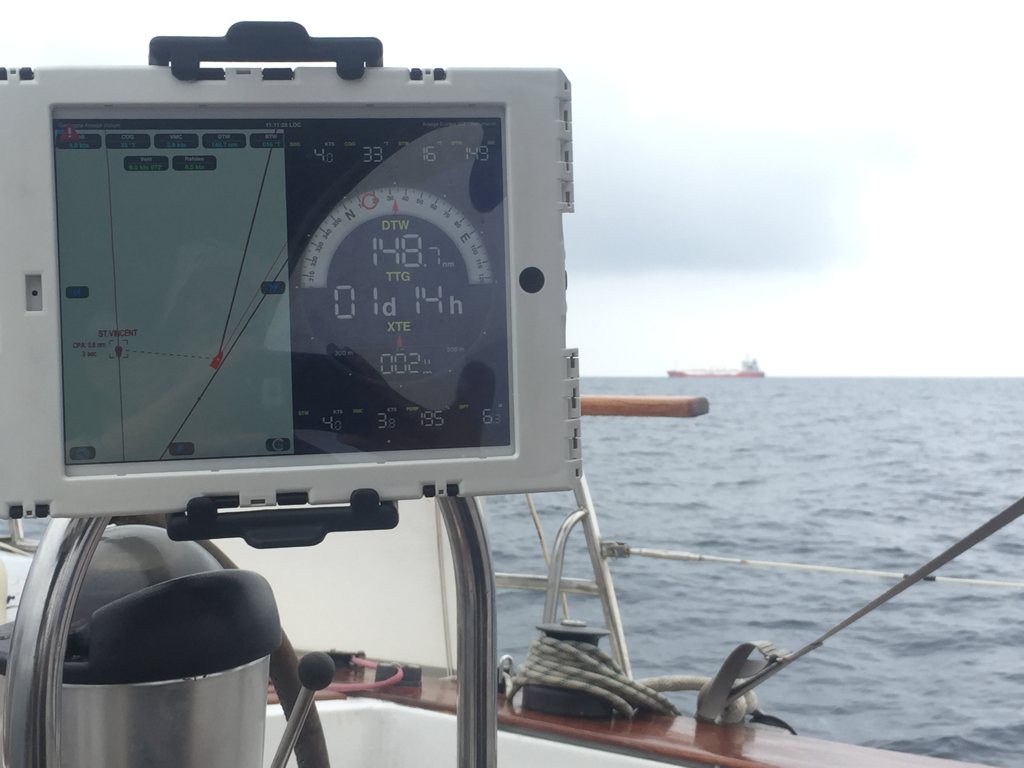 For several years it is possible to integrate iPads and other mobile devices using Wi-Fi to onboard instruments. This allows navigation apps to, not only to receive all the data from the sensors : speedometer, anemometer, sounder, AIS, aso, but also to send their own navigation data to the instruments, as, in example, to control an autopilot.
For several years it is possible to integrate iPads and other mobile devices using Wi-Fi to onboard instruments. This allows navigation apps to, not only to receive all the data from the sensors : speedometer, anemometer, sounder, AIS, aso, but also to send their own navigation data to the instruments, as, in example, to control an autopilot.
This integration takes place through devices called "gateways" or "routers" that connect to the instruments' networks, receive the data circulating through these networks, and transceive in Wi-Fi to tablets and smartphones. Some navigation applications are being developed to process this data and transform mobile devices into real navigation centers.
Expressed in this way, it seems at first relatively simple. Actually, We are quickly confronted with the multiplicity of networks and communication protocols used by marine electronics manufacturers for many years : SeaTalk1, SeaTalkNG, SimNet, Topline, Micronet, NMEA0183, NMEA2000, and I may be forgetting some. Enough to get serious headaches !
Fortunately, the manufacturers of these gateways have tried to address the multiple situations encountered with the instruments of all brands and above all generations. Indeed, many boats are still equipped with instruments dating back several decades associated with more recent ones, and different brands, so with different communication systems.
This is why these Wi-Fi gateways are usually multichannel transceivers called Multiplexers, able to process data simultaneously NMEA0183 (¹) from multiple instruments, data from a network NMEA2000 (²), and sometimes the data SeaTalk1 from Raymarine older generations instruments. All these data are converted into a single stream exported to the Wi-Fi module, USB output, sometimes other ports NMEA0183. Data are translated on the fly from a protocol in the (or more) other(s). In addition, communication can be bi-directional, This allows navigation apps to send their own data back to the Wi-Fi module, either to control an autopilot, either to feed a tracker or repeaters, regardless of their brand and communication protocol.
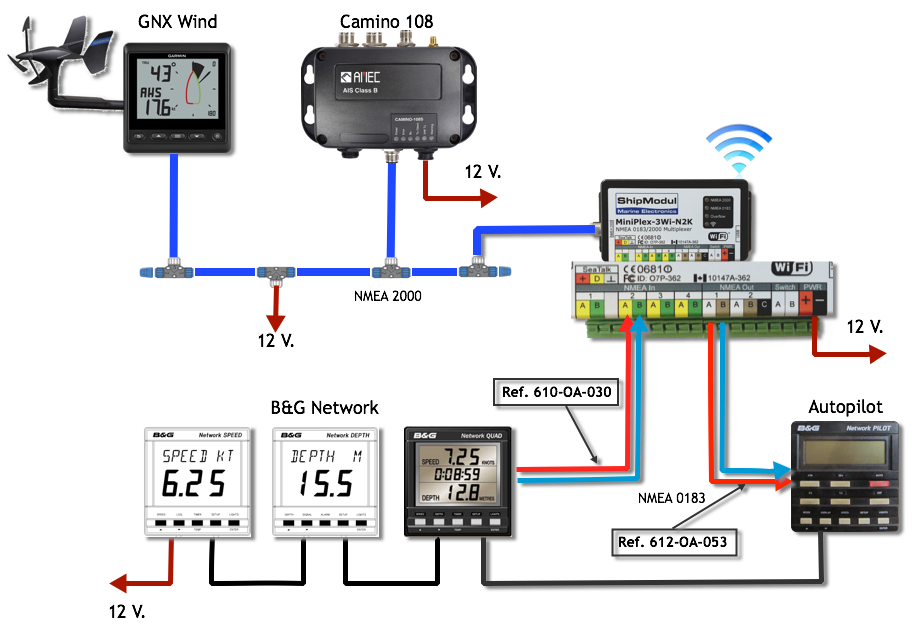
Example of installation with a mixed NMEA0183 and NMEA network 2000 and instruments of different brands.
To my knowledge, The first multiplexer worthy of the name was the iMuX by Brookhouse in fall 2010 (since disappeared). This device, Quite close to amateur DIY, already made it possible to connect several NMEA0183 instruments and possibly SeaTalk1. Unfortunately, its lack of reliability and chaotic marketing in France did not make it a great success. Since then several units dedicated to yachting came up, a micro-market sometimes used by small companies whose sustainability is not always assured.
Some examples
I selected four gateways that met the primary criterion of supporting the NMEA protocol 2000. This allows connect all the instruments designed for ten years by the major brands of yachting : Raymarine, B&G, Simrad, Garmin, Furuno, aso. Not all gateways support the protocols of older instruments, The choice is therefore to be made according to the combination of instruments on board. A contrario, there is no point to choose a gateway that supports SeaTalk1 protocol if you do not own the ST60 or earlier Raymarine range.
-
Digital Yacht NavLink 2
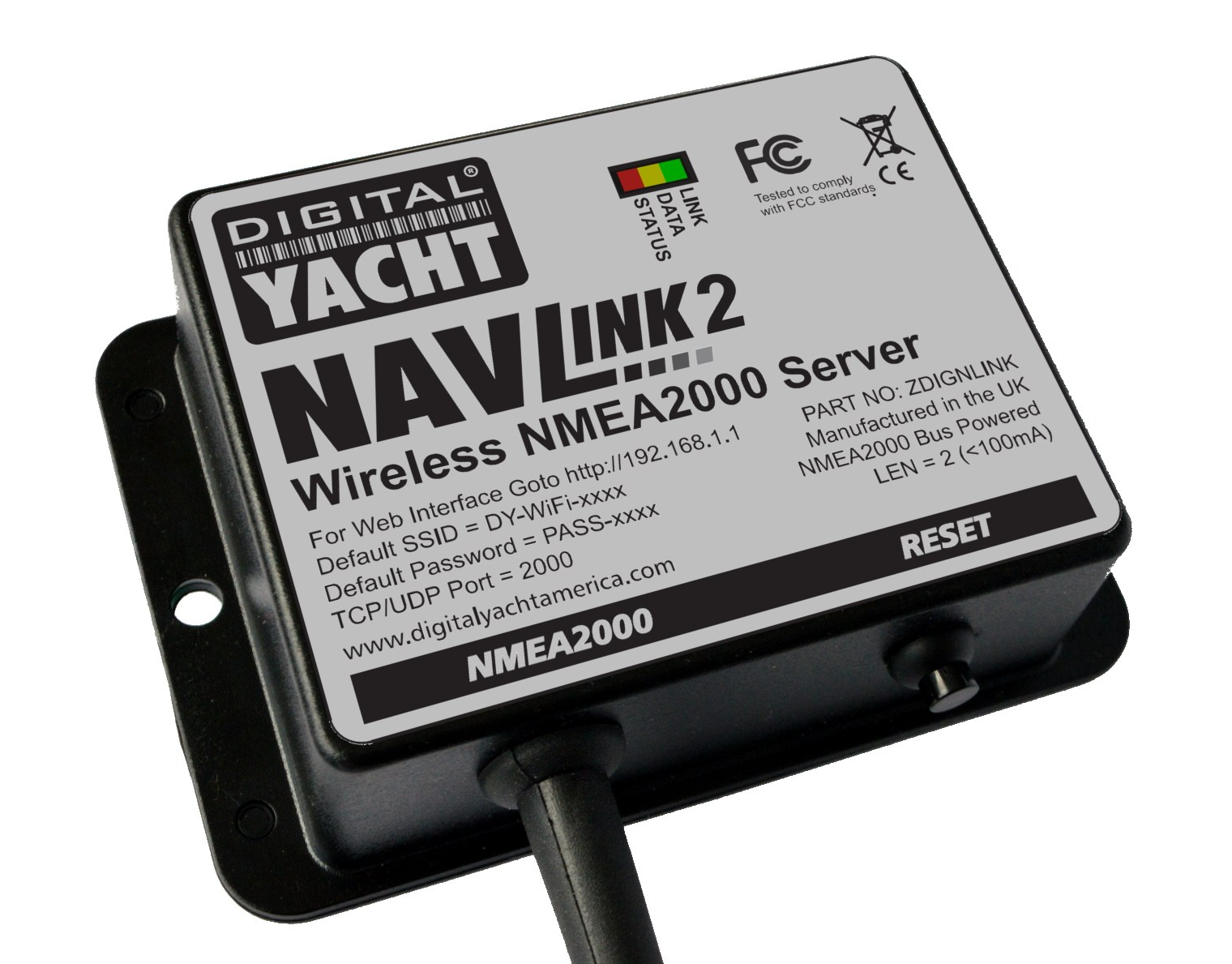 NavLink 2 only supports the NMEA 2000. protocol. It is also the easiest Wi-Fi router to install. It builds its own Wi-Fi hotspot and supports TCP modes (Connection to a single mobile device) and UDP (Multiple connections). It is configured in "Access Point" mode (default mode) or "Client" of an existing Wi-Fi network. It can connect up to 7 Wi-Fi devices. It translates on the fly incoming NMEA 2000 data to NMEA0183 data output via Wi-Fi, and vice versa for received data from mobile applications.
NavLink 2 only supports the NMEA 2000. protocol. It is also the easiest Wi-Fi router to install. It builds its own Wi-Fi hotspot and supports TCP modes (Connection to a single mobile device) and UDP (Multiple connections). It is configured in "Access Point" mode (default mode) or "Client" of an existing Wi-Fi network. It can connect up to 7 Wi-Fi devices. It translates on the fly incoming NMEA 2000 data to NMEA0183 data output via Wi-Fi, and vice versa for received data from mobile applications.
The configuration is reduced to its simplest expression : it contains a built-in web page accessed with any browser, allowing you to change the network mode, to change the Wi-Fi password of the device, Wi-Fi channel, and select UDP or TCP mode. You can open a window to view the data NMEA0183 that is passing through. Finally, the interface allows you to update the internal firmware.
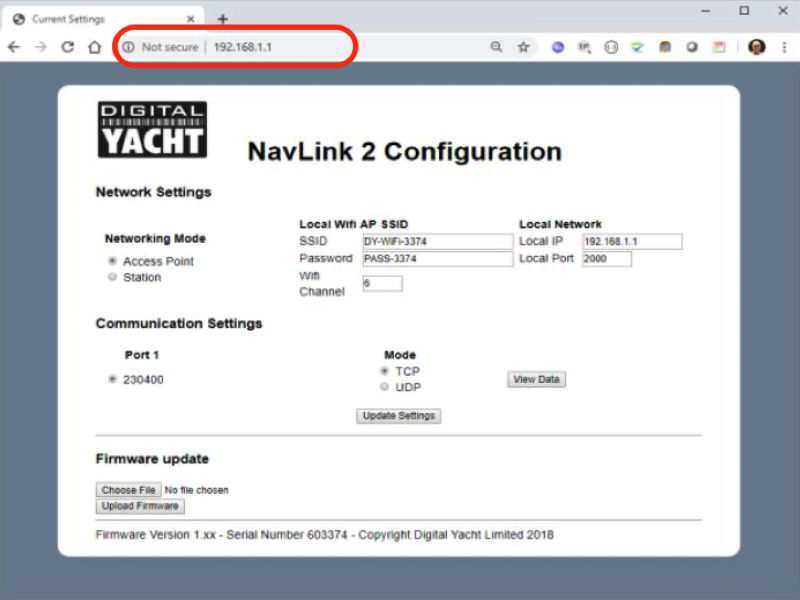 NavLink 2 is only water-resistant, IP54 standard (³) and must therefore be installed in a dry place. It is the ideal device for basic installations, but which will only meet simple needs, preferably an NMEA network 2000 of the same brand, and mobile applications only returning standard NMEA0183 data.
NavLink 2 is only water-resistant, IP54 standard (³) and must therefore be installed in a dry place. It is the ideal device for basic installations, but which will only meet simple needs, preferably an NMEA network 2000 of the same brand, and mobile applications only returning standard NMEA0183 data.
-
Actisense W2K-1
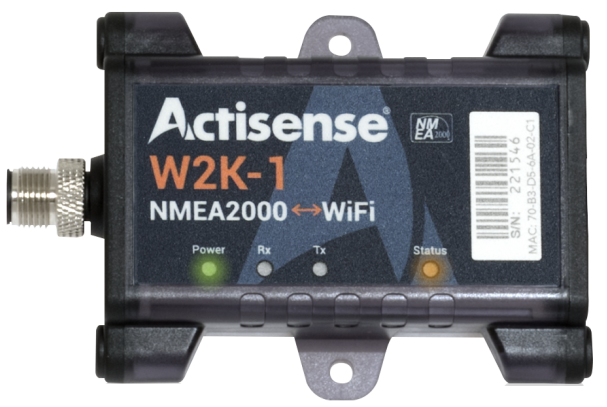 Like the previous router, W2K-1 only supports NMEA 2000. However, it translates NMEA data 2000 in NMEA0183 bi-directionally and simultaneously on 3 different servers (3 harbours) configurable, all streamed over Wi-Fi. It supports TCP and UDP modes that can be assigned to each server. The W2K-1 creates its own Wi-Fi access point, but can also be integrated as a client of an existing wireless network. Transmit the data up to 150 Mbps at a radio frequency 2,4 GHz. This is ideal for high-speed protocol NMEA 2000. It is provided with an SD Card 8 GB to record the data stream for subsequent analysis, to 4 down to 100 days depending on the number of connected instruments and thus the volume of data processed. Configuration and firmware updates are carried out via an internal web interface that can be accessed with any browser. The Wi-Fi access point supports up to 4 simultaneous connections (4 mobile devices).
Like the previous router, W2K-1 only supports NMEA 2000. However, it translates NMEA data 2000 in NMEA0183 bi-directionally and simultaneously on 3 different servers (3 harbours) configurable, all streamed over Wi-Fi. It supports TCP and UDP modes that can be assigned to each server. The W2K-1 creates its own Wi-Fi access point, but can also be integrated as a client of an existing wireless network. Transmit the data up to 150 Mbps at a radio frequency 2,4 GHz. This is ideal for high-speed protocol NMEA 2000. It is provided with an SD Card 8 GB to record the data stream for subsequent analysis, to 4 down to 100 days depending on the number of connected instruments and thus the volume of data processed. Configuration and firmware updates are carried out via an internal web interface that can be accessed with any browser. The Wi-Fi access point supports up to 4 simultaneous connections (4 mobile devices).
The icing on the cake : it is a full waterproof unit, IP67 standard (³). A gateway particularly suited to wet environments on racing boats and offshore racing, equipped generally with very recent instruments.
-
Yacht Devices YDNR-02N
This Wi-Fi router is a multiplexer that supports NMEA protocols 2000, NMEA0183 and SeaTalk1. It creates its own Wi-Fi access point and can also be integrated into an existing Wi-Fi network in client mode. It converts data between the three supported protocols to bi-directional. In "Access Point" mode, it allows up to 3 simultaneous connections with 3 Parallel Servers. Each port (server) Allows 3 TCP or unlimited UDP connections. It has a powerful system of filters of the output data, which allows you to adapt to the capabilities of mobile applications.
YDNR-02N incorporates an extended web server allowing, a complete configuration of the 2 NMEA0183 input/output ports, SeaTalk Harbor, and data filters. In addition, A measurement gauge web page allows you to manage the digital switch module and view the ship's data in real time using a web browser on a computer, a laptop, a tablet or smartphone. The end of the end, if you access to your boat Wi-Fi network via Internet, Web gauges can be an effective solution for monitoring and managing your boat.
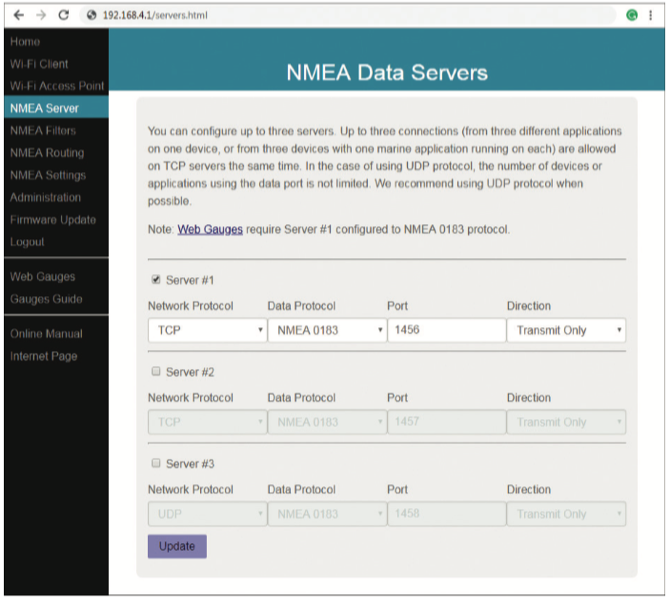 The free CAN Log Viewer software, available on the manufacturer's website (Windows, Linux and MacOS) is used to display messages and NMEA 2000 and J1939 in real-time, configure NMEA 2000 instruments and to update the firmware of the device.
The free CAN Log Viewer software, available on the manufacturer's website (Windows, Linux and MacOS) is used to display messages and NMEA 2000 and J1939 in real-time, configure NMEA 2000 instruments and to update the firmware of the device.
This more technical router than the two previous will also be more complex to set up, but in return it will adapt to heterogeneous instrument configurations. A defect : The case is waterproof, but not the connectors ramp..
-
MiniPlex-3Wi-N2K
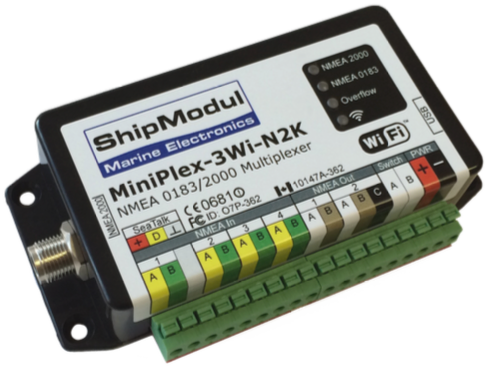 This multiplexer represents the "Swiss Army knife" of Wi-Fi gateways. Came up in 2016, the ShipModul company has since made several firmware enhancements to make the router to do everything, or almost. It provides a connector NMEA 2000, 4 input ports NMEA0183 including one converts SeaTalk1 , 2 NMEA0183 Output Ports, a USB connector and the Wi-Fi module. Like the previous ones, it creates its own Wi-Fi access point and can be configured in "client" mode of an existing Wi-Fi network. It works in TCP or UDP and accepts 5 simultaneous connections (4 UDP + 1 TCP). It simultaneously translates all three protocols into bi-directional using buffers (buffers) to regulate streams. In addition, All NMEA0183 ports are adjustable rate, to 4800 down to 57600 input, and up to 115200 Output baud. It has very powerful filters for regulating the output data, and thus avoid overflows (buffers overcapacity).
This multiplexer represents the "Swiss Army knife" of Wi-Fi gateways. Came up in 2016, the ShipModul company has since made several firmware enhancements to make the router to do everything, or almost. It provides a connector NMEA 2000, 4 input ports NMEA0183 including one converts SeaTalk1 , 2 NMEA0183 Output Ports, a USB connector and the Wi-Fi module. Like the previous ones, it creates its own Wi-Fi access point and can be configured in "client" mode of an existing Wi-Fi network. It works in TCP or UDP and accepts 5 simultaneous connections (4 UDP + 1 TCP). It simultaneously translates all three protocols into bi-directional using buffers (buffers) to regulate streams. In addition, All NMEA0183 ports are adjustable rate, to 4800 down to 57600 input, and up to 115200 Output baud. It has very powerful filters for regulating the output data, and thus avoid overflows (buffers overcapacity).
Unlike previous routers, Configuration is only done from a utility available for download on the manufacturer's website (Windows and MacOS). A web interface is also present in the device, but it is only used to manage the internal characteristics of the device and the network communication modes.
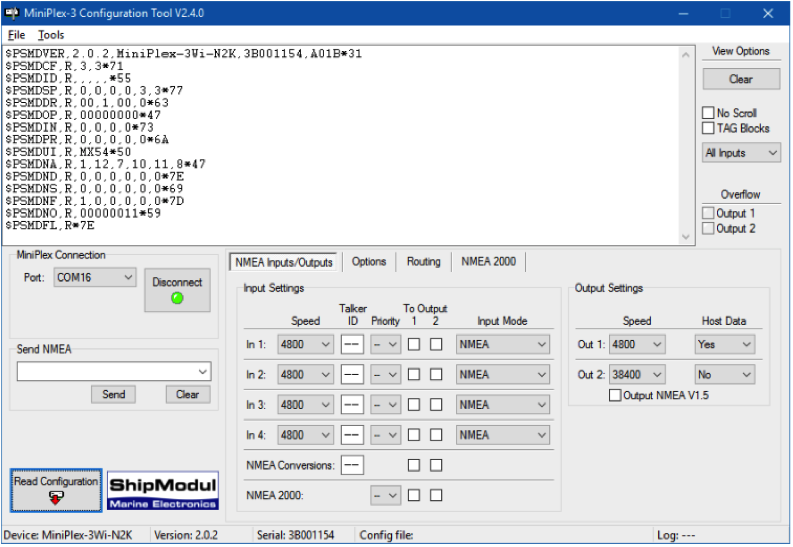 The housing is made of fireproof ABS, but not waterproof. It is therefore necessary to install it in a dry and sheltered place. Today is in France the most usually installed device, especially on used sailing boats, because it can manage all scenarios and allows a very thin configuration data flow.
The housing is made of fireproof ABS, but not waterproof. It is therefore necessary to install it in a dry and sheltered place. Today is in France the most usually installed device, especially on used sailing boats, because it can manage all scenarios and allows a very thin configuration data flow.
These four devices are obviously not exhaustive, but they represent a sample of what is most reliable today, Tested with a majority of applications by manufacturers.
–––
(¹) See NMEA in the Glossary, and also Wiring NMEA 0183, not so easy !
(²) See NMEA 2000 in the Glossary, and also NMEA 2000, a network standard of the future
(³) IP protection ratings :
–––
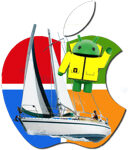

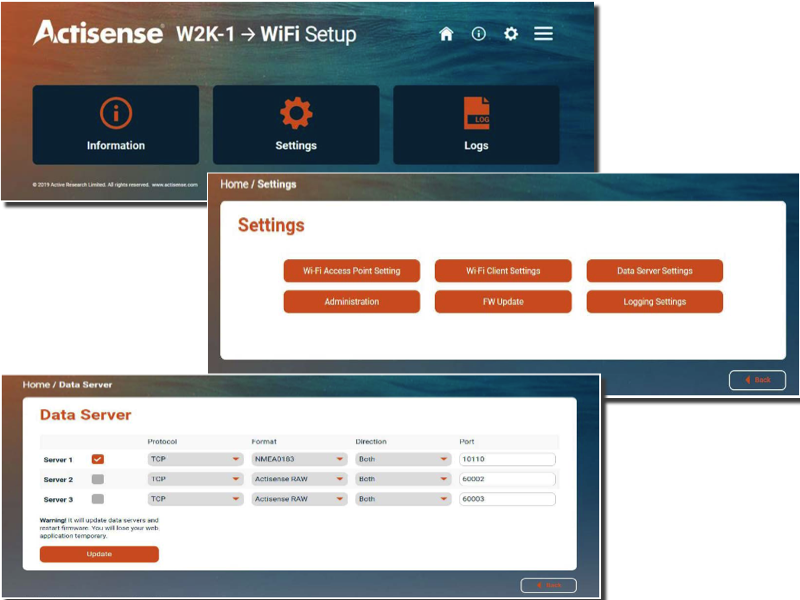
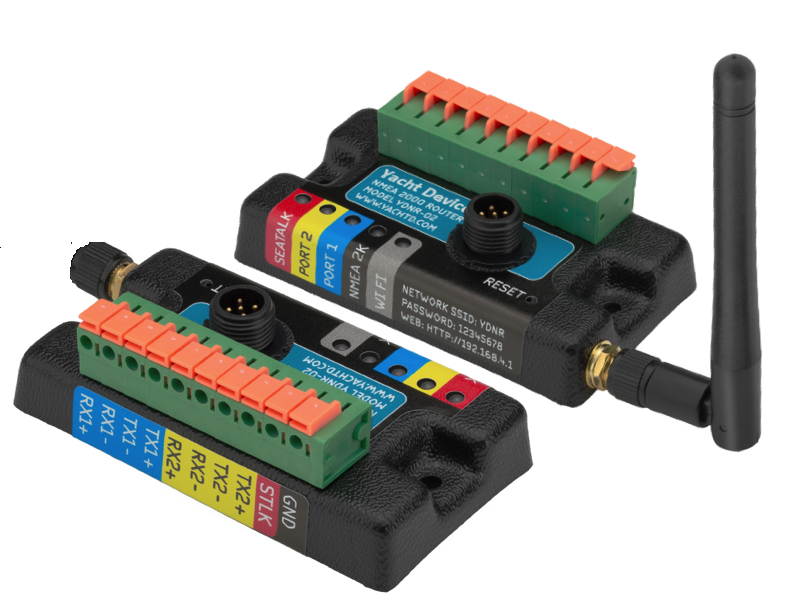
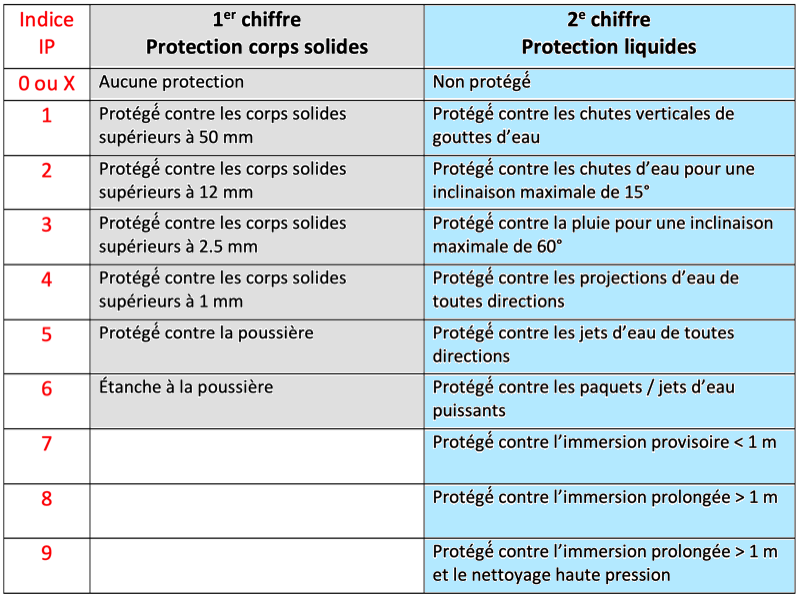
Hello Francis. I’ve followed your pages for a few years, especially in respect of MacENC. I’m sorry that this is now out of date, and that there seem to be no charts available for it.
So, conversion to iPad navigation, with my fingers crossed. At the moment I am using the UK Imray Navigator with their charts and one set of Dutch charts. We spent most of our sailing this year sailing around the UK. There were a few problems, particularly the upgrade of some iPhones and iPads to iPadOS, when the app failed to make routes. Imray have been very helpful, and also very apologetic. This has been fixed in the past month or so.
From that, I have upgraded the ShipModul multiplexer to a MiniPlex-3Wi-N2K, because the pressure is on for NMEA2000 and for wi-fi instruments.
This is to let you know that MPX-Config v.3 works very well on a MacBook with the latest OS, and changing the older MiniPlex for the newest one was reasonably simple.
Thank you for your wonderful website – it has been of great use to our sailing.
Hugh Morrison
It is never too late to answer: a great thank you for you kind comment. FYI ShipModul has published a new Wi-Fi firmaware V.1.5.0, including new device firmware 2.3.4:
http://www.shipmodul.com/en/downloads.html
http://www.shipmodul.fr/fr/downloads.html